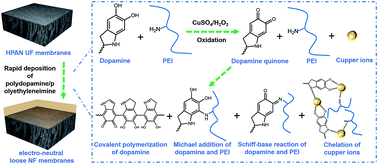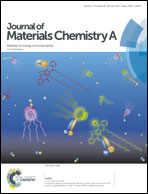High flux electroneutral loose nanofiltration membranes based on rapid deposition of polydopamine/polyethyleneimine†
Abstract
A rational manipulation of the surface structures and properties of thin-film composite membranes is important to optimize their separation performance and service durability. In this study, a facile strategy is reported for fabricating electroneutral loose nanofiltration membranes based on the rapid co-deposition of biomimetic adhesive polydopamine and poly(ethylene imine) (PEI) by using CuSO4/H2O2 as a trigger. Through this strategy, the surface properties and the filtration performance of the membranes can be easily tailored by the addition of PEI and CuSO4/H2O2, as well as tuning the deposition time. UV, XPS, SEM, AFM, zeta potential, water contact angle and nanofiltration measurements were used to investigate membrane performance. Surface characterization revealed that overall enhanced surface properties including low roughness, favourable hydrophilicity, and relatively neutral charge can be achieved after the addition of PEI. The optimum membranes, with 1 h co-deposition of PDA and PEI, show an ultrahigh water permeability (26.2 L m−2 h−1 bar−1), distinguished rejection for both negatively and positively charged dyes and a high permeation of divalent salts (>90%). Furthermore, the optimum membranes also show excellent operational stability in long-term nanofiltration operations in alkaline solution. This study provides an efficient and facile approach to tailor the membrane properties and structure for loose nanofiltration membranes.



 Please wait while we load your content...
Please wait while we load your content...